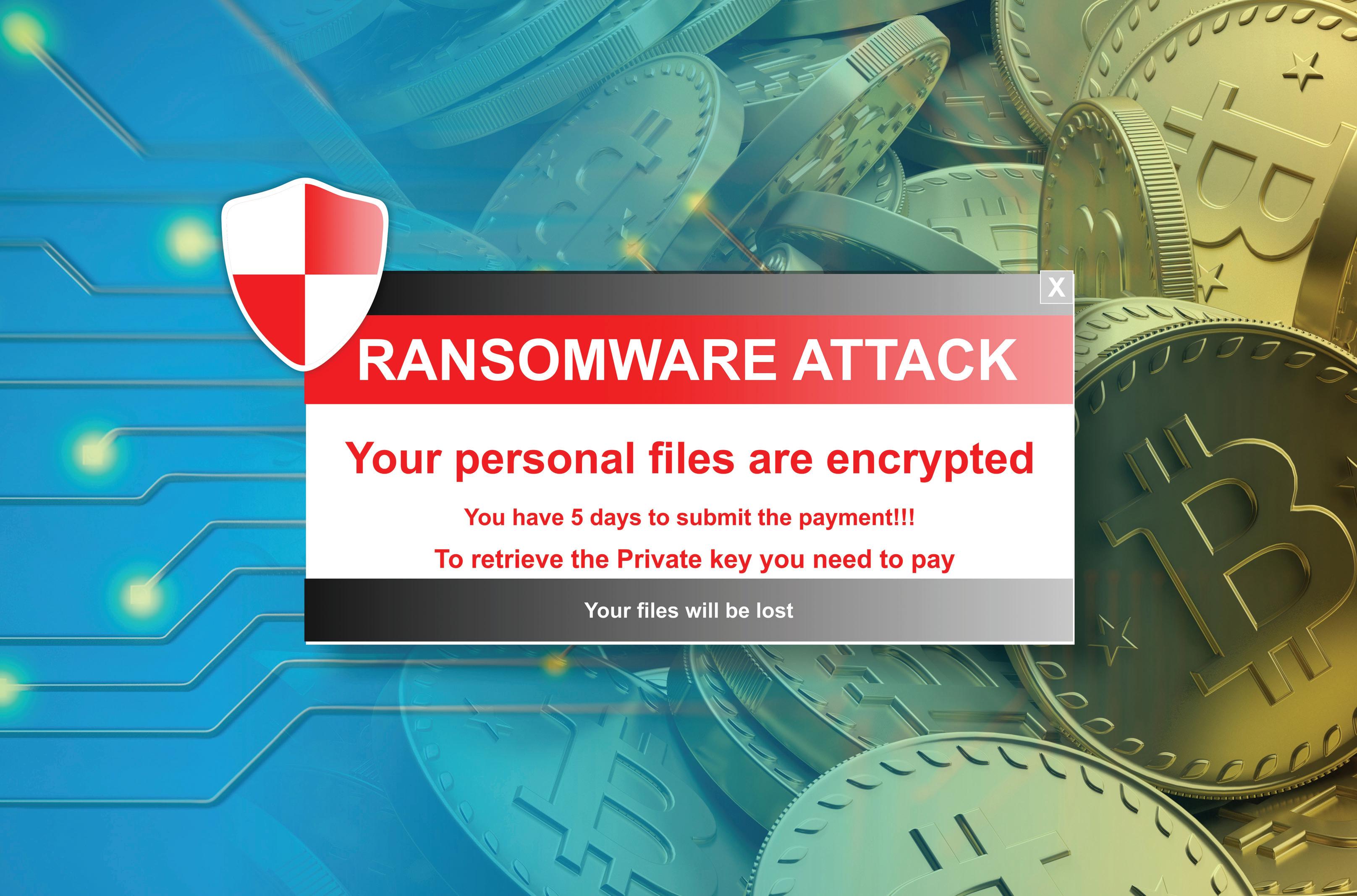
16 minute read
Self-Directed Solo 401(k) Retirement Plans: The Underutilized EfficiencyMaximizer
By Whitney Nash, CPFA
How can I save money on my taxes?” CPAs are frequently asked this question and are expected to share ideas and options on how to maximize deductions, lower taxable income, and reduce and/ or defer tax liabilities. Suggesting the adoption of a retirement plan to their business-owner clients is often a viable recommendation. The plan that is recommended, however, makes a big difference. When it comes to clients who have income from selfemployment as 1099 independent contractors, or business owners with no W-2 employees working more than 1,000 hours per year, this is especially true. It is common for CPAs to recommend SEP IRAs or Solo 401(k)s to this type of client, among a few other less popular options. Both offer high contribution limits and other beneficial provisions, but they are still lacking in one way or another. The SEP IRA does not permit loans to be taken out or elective salary deferral contributions, so Roth and catch-up contributions cannot be made. The Solo 401(k) offers loan and salary deferral options, but it does not allow the client/account holder to be the trustee and self-direct funds to be invested in alternative assets, such as real estate, certain businesses, hard money lending, etc. (See Figure 1 for a side-by-side comparison chart.) With the growing popularity of portfolio diversification into alternative asset classes, real estate in particular, the Self-Directed Solo 401(k) might be a welcome alternative.
CPAs who gain an understanding of this underutilized strategy could position themselves as a great resource to help their clients who meet the eligibility requirements, the pool of which is growing.
Eligibility Requirements to Adopt a Self-Directed Solo 401(k) Plan
To determine if someone qualifies for a Self-Directed Solo 401(k), two criteria must be met. First, they
must have earned income from selfemployment. Keep in mind, Schedule E (rental, dividend and royalty) income does not qualify. It does not matter what their entity type is or if they are a sole proprietor.
Second, the business owner, or 1099 independent contractor, cannot have any W-2 employees working more than 1,000 hours per year. Businesses with partners as the only full-time workers, spouses who are employees or partners, and full-time 1099 independent contractors working with the business are all acceptable and do not negate eligibility.
The business owner just cannot have any W-2 employees working more than 1,000 hours per year … for now. The SECURE Act changed the 1,000 hours per year rule. It states that retirement plans will need to be offered to part-time employees who have “… three consecutive 12-month periods during each of which the employee has at least 500 hours of service” (see Neal, Richard E. “Text - H.R. 1994 - 116th Congress (20192020): Setting Every Community Up for Retirement Enhancement Act of 2019.” Congress.gov, 3 June 2019, https://bit. ly/3esPyft) and who satisfy the plan’s minimum age requirement of 21 years of age.
Hours of service during 12-month periods before January 1, 2021, will not be considered. The clock started on January 1, 2021, so these plans will not be affected until January 2024. The IRS is expected to release more guidance on this new rule. See Section 112 of the Act for more information: https://bit.ly/3esPyft.
Spouses and business partners who earn income from the business can each have their own account under the Self-Directed Solo 401(k) plan. In the case of spouses, this could possibly double, or more depending on age, the contribution limits and tax-deferral amount for their household. Any 1099 independent contractors working with them can adopt their own plan for their business, as well.
If the account holder also has a W-2 job, they can still have a SelfDirected Solo 401(k) plan and contribute to their W-2 employer’s plan, per the applicable allocation rules and combined contribution limit for elective salary deferral. It is important to note that control group issues could affect eligibility, so each client’s circumstances will have to be considered.
Contribution Types Allowed and Limits
The Self-Directed Solo 401(k) allows for pre-tax contributions to be made two different ways: Salary Deferral and Profit-Sharing.

Figure 1.
HOW THEY ARE DIFFERENT
SEP IRA
Is it OK to have full-time W-2 employees
Loans are not allowed
Salary deferral contributions cannot be made, so no Roth option or catchup for those 50+
Does not allow for voluntary aftertax contributions
Account holder cannot be the trustee or custodian, which will increase the cost
Is subject to Unrelated DebtFinanced Income Tax (UDFI)
Requires Form 5498 and an annual valuation of certain assets
S-D SOLO 401(K)
Is it not OK to have full-time W-2 employees working >1,000/yr
Loans are allowed, per applicable rules and limits
Includes salary deferral, so it allows for Roth and catch-up for those 50+
Voluntary after-tax contributions are allowed
Account holder is the trustee and no custodian is needed, which keeps the cost low
Is not subject to Unrelated DebtFinanced Income Tax (UDFI) when applicable rules are followed
Only requires Form 5500 if the plan balance is over $250k
Salary Deferral - With salary deferral, the account holder can contribute: • 100% of net earnings/salary from self-employment up to a maximum of $19,500. • Those who are 50 years old or older qualify for the additional catch-up contribution of $6,500, bringing their salary deferral maximum to $26,000. • These are the limits for 2020 and 2021.
Profit-Sharing - In addition to salary deferral, the account holder can make a profit-sharing contribution: • Those set up as an LLC, partnership or sole proprietor can contribute up to 20% of their net earnings from self-employment. • Those set up as C corporations and S corporations can contribute up to 25% of their salary from selfemployment.
Combined Limit - The 2020 contribution limit for the salary deferral and profit-sharing, combined, cannot exceed $57,000 for those under 50 years old or $63,500 for those 50 and over. The 2021 combined limit is $58,000 and $64,500, respectively. Again, this is the maximum amount allowed; the account holder does not have to contribute the full amount.
Since the SEP IRA’s annual limit is $57,000 ($58,000 for 2021) as well, it is important to understand the breakeven income level when the 20% or 25% profit-sharing contribution will equal $57,000 ($58,000 for 2021) and the salary deferral addition no longer helps to increase the contributable amount.
For 2020, the break-even net income is $285,000 ($290,000 for 2021) for LLCs, partnerships and sole proprietors, and $228,000 ($232,000 for 2021) for C corporations and S corporations. However, if the person is 50 years old or older, the catch-up contribution portion of the salary deferral will increase the limit to $63,500 ($64,500 for 2021). So, for anyone in this age group, the Self-Directed Solo 401(k) would be superior to the SEP IRA from an overall contribution limit standpoint.
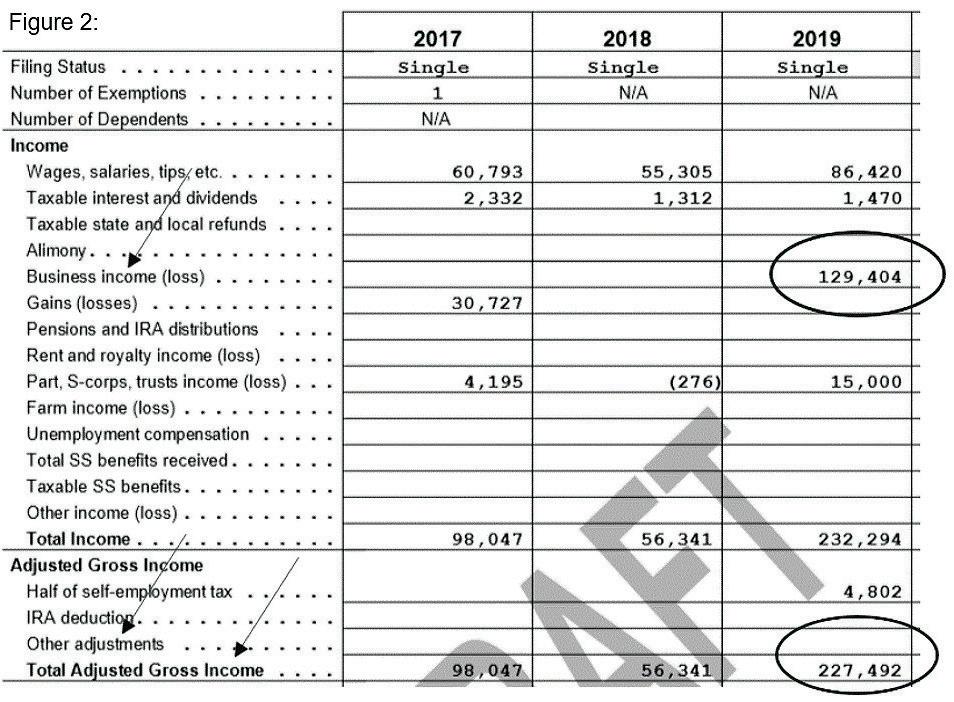
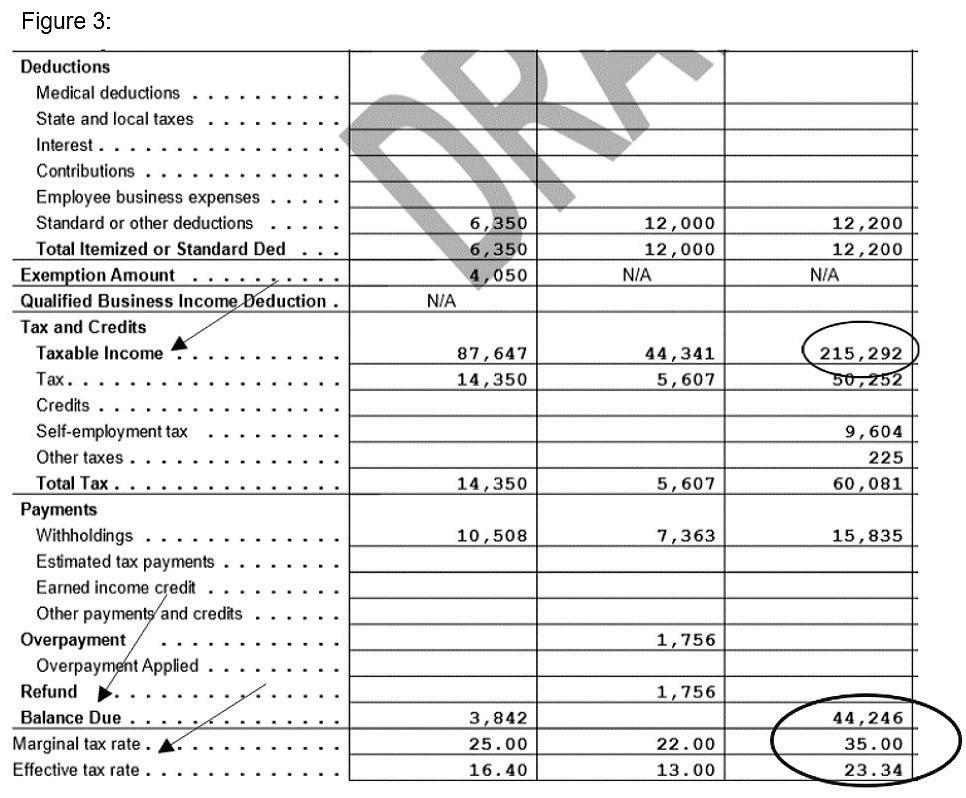
Case Study: Contribution Effect on Tax Liability and Savings Amount
This is a case study from an actual client, “Michael.” He is employed by a company that pays him a base W-2 salary (without qualified plan deductions) along with 1099 commissions that are paid to his LLC. Michael is 26 years old, single with no kids, lives in Texas, and adopted his Self-Directed Solo 401(k) plan in December of 2019. When it came time to prepare Michael’s 2019 tax return, his CPA ran the numbers to compare his tax liability if he made no contribution to the plan versus making the maximum contribution
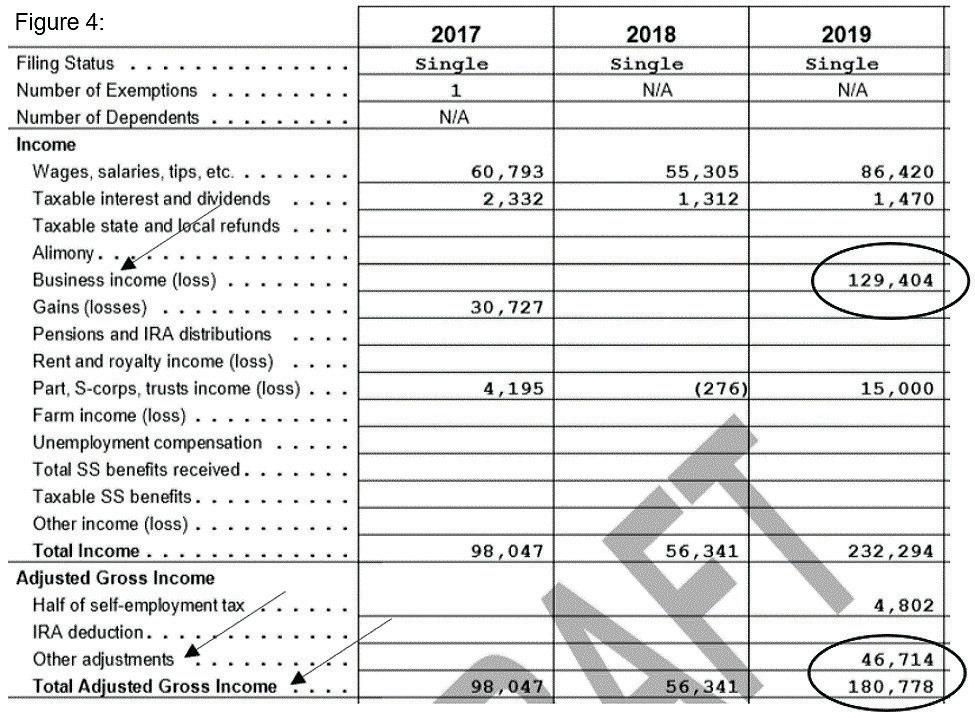
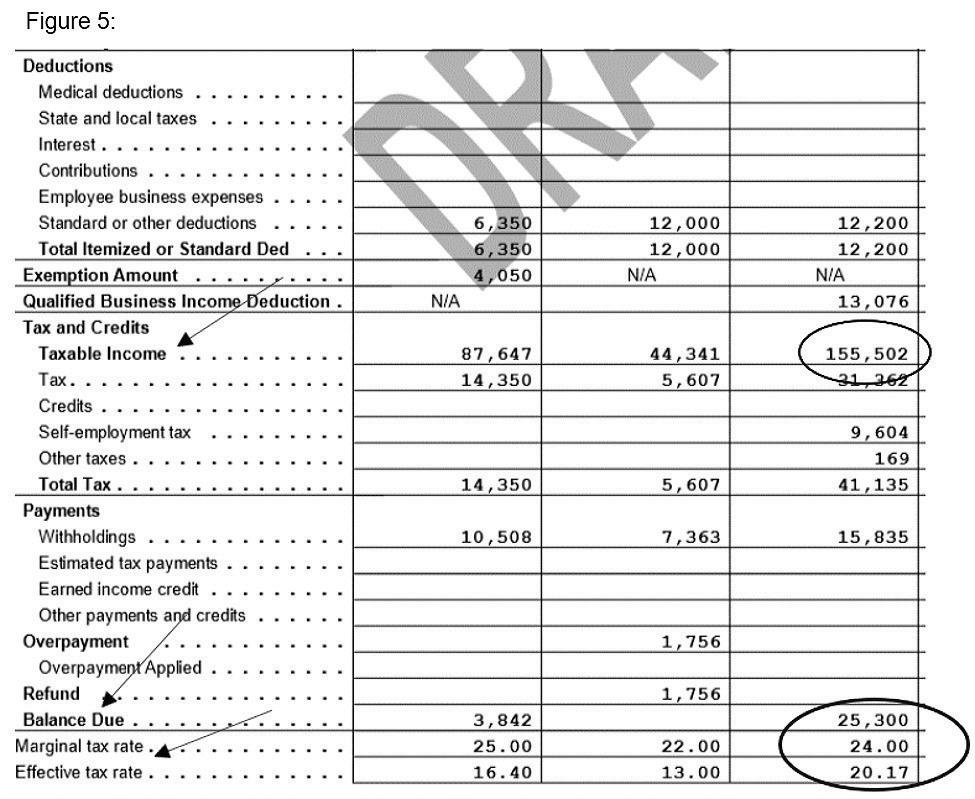
allowed. Figure 2 is the top portion of Michael’s Form 1040 Comparison Table, which shows that he started making 1099 income, in addition to his wages, in 2019.
Since no contribution to his SelfDirected Solo 401(k) is made in this scenario, there is no amount shown on the Other adjustments line, so his AGI is $227,492. Figure 3 is the bottom portion of Michael’s Comparison Table. His Taxable Income shows as being $215,292, with a Balance Due of $44,246. The Marginal tax rate is 35% and the Effective tax rate is 23.34%.
As seen in Figure 4, if Michael does contribute the maximum that he is allowed, the Other adjustments line shows his contribution amount of $46,714 and a reduced AGI of $180,778. As seen in Figure 5, the contribution brought Michael’s taxable income down to $155,502 and his tax liability went from being $44,246 to owing only $25,300. His marginal tax rate dropped down two brackets and his effective tax rate is reduced by over 3%. Michael was able to decrease his tax liability by $18,946, which is a 42.8% reduction.
Needless to say, he chose to make the maximum contribution to his plan and is enjoying the tax savings. Michael is also an avid real estate investor, so he can self-direct the $46,714 contribution toward assets that match his preferred investment strategy.
Additional Contribution Options (If the Plan is Designed to Include Them)
Aside from contributing to a SelfDirected Solo 401(k) with pre-tax dollars, Roth and Voluntary AfterTax contributions can also be made. These options open the door for $57,000 or $63,500 ($58,000 or $64,500 for 2021) depending on age, to be contributed to a Roth account every year, per future limits.
Roth - The salary deferral portion can be contributed after-tax to a designated Roth account, which is not limited to the income cap. For clients who are not particularly concerned about tax savings through deferral today and want to increase their taxfree money in retirement as much as possible, they could make Roth salary deferral contributions along with the pre-tax profit-sharing contributions.
They would then convert the profitsharing contribution to the Roth account and pay the tax on it. From there, the client can invest all of the funds through their Roth account so that the basis, income and gain will all be tax free upon withdrawal.
Voluntary After-Tax - 100% of net income from self-employment, up to the annual limit, can be contributed
after-tax. Since the income and gain on after-tax contributions is taxable upon withdrawal, the client will want to convert the money to the Roth account right away and report it with information from Form 1099-R. The strategy of contributing voluntary after-tax funds and then converting them to a Roth account is commonly referred to as a Mega Backdoor Roth.
Contributing after-tax dollars is also a way to maximize, and reach, the contribution limit amount of $57,000 or $63,500 ($58,000 or $64,500 for 2021) since it can be made in addition to the salary deferral and profitsharing contributions.
For example, look at Michael’s case study again. He could only contribute $46,714 because of his income level. If Michael wanted to max out the full contribution amount allowed, he could have added an additional $9,286 of after-tax dollars to reach the 2019 limit of $56,000. the account holder has 15 years to pay it back. Interest is owed on the loan, typically prime plus 1%, but the interest goes back into the 401(k) account and added to the retirement funds, as opposed to it going to a financial institution, which would be the case with a typical loan. Payments must be made no less than quarterly. Any amount not repaid from a loan (after grace periods are exhausted) will be considered a distribution and any applicable taxes and penalties will be due by the account holder.
The Self-Directed Solo 401(k) essentially becomes the account holder’s personal bank that will lend money without an application or underwriting. They can borrow from the plan, instead of being in debt to another institution or person. Also, business owners who use a loan to fund their business can expense the interest they are paying back to the account and treat it the same as if they were paying interest to a bank for a business loan.
Timing and Methods for Contributing to the Plan
will want to make at least a small contribution every few years so that it does not appear to the IRS that the plan is no longer active and thus no longer valid. In addition to funding the account with salary deferral, profit-sharing and voluntary after-tax contributions, the account holder can roll their current retirement account(s), in part or in whole, into the plan to increase the asset class diversification potential. Any pre-tax account can be used, such as IRAs, SEP IRAs, old 401(k)s, etc., but no pre-existing Roth, after-tax or HSA account can be rolled into the plan. Information from Form 1099-R will need to be used to report the rollover on Form 1040 for the tax year that the rollover took place.
Those who are 50 years old or older
The salary deferral and profit-sharing contributions can be made in any amount qualify for the additional catch-up contribution of $6,500... and at any time, per applicable limits, deadlines and payroll schedules. This means that the account holder can make contributions on any schedule that works for them, such as biLoan Feature (If the Plan is Designed to Include It) monthly, monthly, quarterly, annually One of the best provisions found in or at random. It is not mandatory Self-Directed Solo 401(k) plans is the to make contributions; they can be loan feature. This allows the account missed here and there, or not made holder the ability to borrow up to at all. There is no minimum amount $50,000 or 50% of the balance in the required when making a contribution account, whichever is less, tax and and the amount can be changed as penalty free. The money can be used needed. for anything without restriction. Multiple loans can be taken out at any After the initial contribution to make time so long as the combined amount the plan effective, which should does not exceed the limit and the happen within a couple months of the applicable rules are followed. plan adoption, future contributions do not have to be made if the account Generally, the repayment period is holder chooses not to, for whatever five years, but if it is used for the reason. That said, the account holder purchase of a primary residence,
Investment Options for Self-Directed Solo 401(k)s
Assets that it can invest in.
Another great advantage to the Self-Directed Solo 401(k) is that the account holder can selfdirect the funds to be invested in almost any asset class, including, but not limited to: • Residential and commercial real estate; • Tax liens, deeds and foreclosures; • Land; • Oil and gas mineral rights; • The stock market, funds, bonds, futures and options; • Most business types; • Private and hard money loans; • Select precious metals and some coins.
Disqualified Person and Prohibited Transaction rules apply when engaging in any investment transaction.
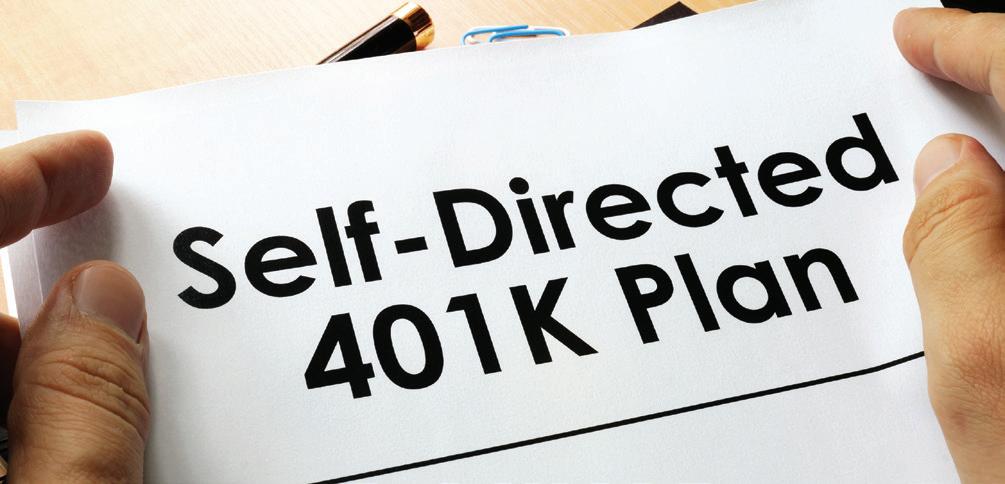
assets disallowed from investment. The one business type that it cannot invest in/be an owner of is an S corporation because the Self-Directed Solo 401(k) cannot be a shareholder of a business. It also cannot invest in art, collectibles such as stamps and baseball cards, or life insurance contracts.
Plan Adoption and Contribution Deadlines
For 2019 and prior years, the SelfDirected Solo 401k plan had to be established by the end of the tax year. The SECURE Act changed this deadline. Starting with the 2020 tax year, business owners can establish a Self-Directed Solo 401(k) plan up until the tax filing deadline, plus extension, for the preceding year.
Contribution deadlines depend on how the business entity is taxed and the type of contribution being made. For LLCs, partnerships and sole proprietors, salary deferral and profitsharing contributions can be made up until the personal tax filing deadline, plus extension. For C corporations and S corporations, the salary deferral portion must be contributed as the salary to be contributed is earned, within at least seven days, and generally through payroll deductions. Profit-sharing contributions can be made up until the corporate tax filing deadline, plus extension.
Independent Firms That are Self-Directed Solo 401(k) Plan Providers
Opening a Self-Directed Solo 401(k) retirement plan is a little different than a regular Solo 401(k) or IRAtype plan. Regular Solo 401(k)s, and other qualified retirement plans like SEP IRAs can be opened at a number of financial institutions that offer retirement plans. Major financial institutions do not typically offer plans for Self-Directed Solo 401(k)s, however, since they act as custodians and the money can get moved away from the products that they sell, such as stocks and mutual funds.
Self-directed funds are also managed by the account holder, as trustee, and do not require a custodian. An independent Self-Directed Solo 401(k) plan provider is able to facilitate and provide this type of plan and give ongoing education and guidance to the account holder, and their CPA/tax preparer, if needed.
Icing on the Cake
Not everyone can afford to shave off a large portion of their net income to maximize their contribution amount, but the Self-Directed Solo 401(k) gives them the option, and the ability, to contribute more than just the profitsharing limit that the SEP IRA allows. The high contribution limit can make a big difference to a business owner’s tax liability and it could possibly bring them down to a lower tax bracket, especially for those with higher incomes. It could also help offset other tax liabilities due to a lack of tax-savings options if, for example, the person’s spouse has a high-paying W-2 job.
The increased flexibility and selfdirection that the Self-Directed Solo 401(k) plan affords is like the icing on the Solo 401(k) cake. For any qualifying client who wants to maximize their contribution options and amounts, maximize tax efficiencies today and/or in retirement, and have direct control over a diversified and personalized investment portfolio, this option checks off more boxes than any other employer-sponsored plan.
ABOUT THE AUTHOR:
Whitney Nash, CPFA, the President and CEO of Nashional Self-Directed LLC, is a Self-Directed Solo 401(k) plan provider and educational consultant in McKinney, TX. She may be contacted at whitney@ nashionalsd.com.
ATTRIBUTION:
Neal, Richard E. “Text - H.R.1994 - 116th Congress (2019-2020): Setting Every Community Up for Retirement Enhancement Act of 2019.” Congress. gov, 3 June 2019, https://bit.ly/3esPyft

Mark Your Calendar and Register for Upcoming CPE
Make your spring learning plans now! TXCPA offers many virtual seminars and online learning options to choose from, so you can find the topics and dates that best fit your schedule. Upcoming May Conference Webcasts
Technology Conference: May 6-7 Energy Conference: May 10-11 Nonprofit Organizations Conference: May 24-25
FREE Professional Issues Updates
These popular offerings are free for TXCPA members and can help you stay on top of the latest professional issues facing you and your clients or companies. Each one is offered from 10 a.m. to noon CT and provides two hours of CPE credit. Wednesday, May 19, 2021 Wednesday, August 25, 2021
TXCPA Passport: On-Demand Webcast Subscription
The TXCPA Passport is an easy, affordable and convenient way to get your CPE hours. For only $199, the one-year subscription gives you unlimited access to one- and two-hour CPE programs that cover a variety of topics, including 80 new programs added in the last few months.
To learn more and register for your CPE programs, go to the Education area of our website at www.tx.cpa/education/cpe or call the TXCPA staff at 800-428-0272 (972-687-8500 in Dallas) for assistance.



